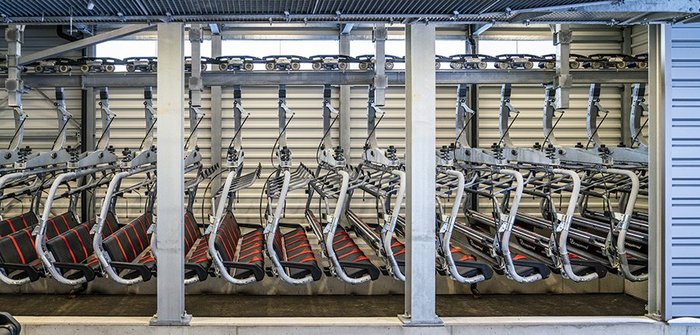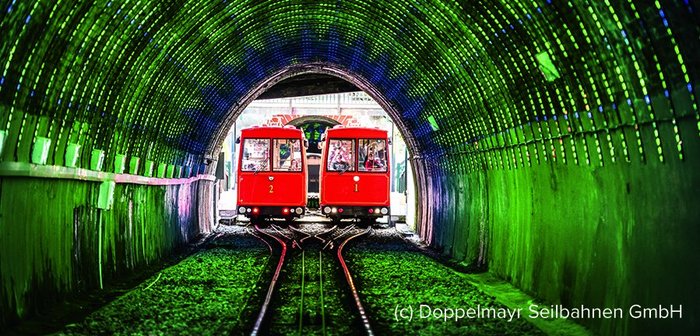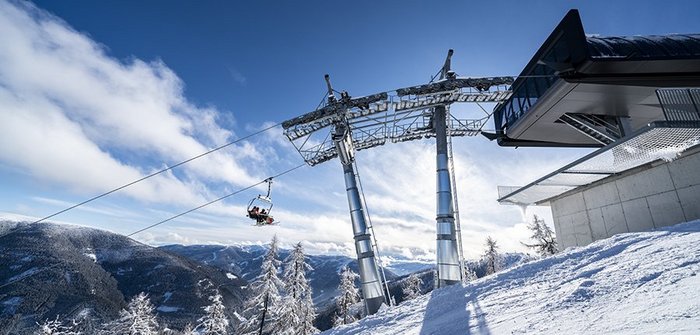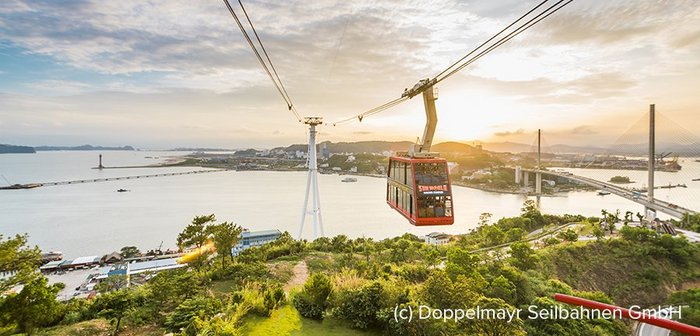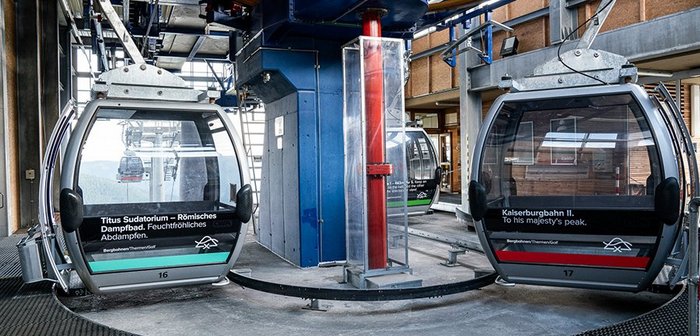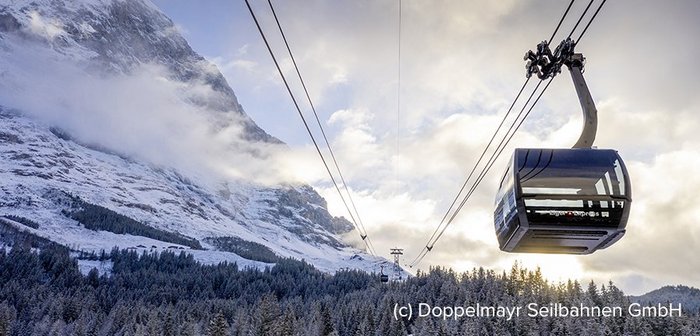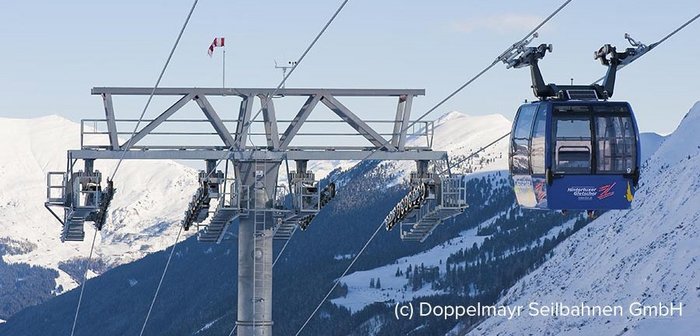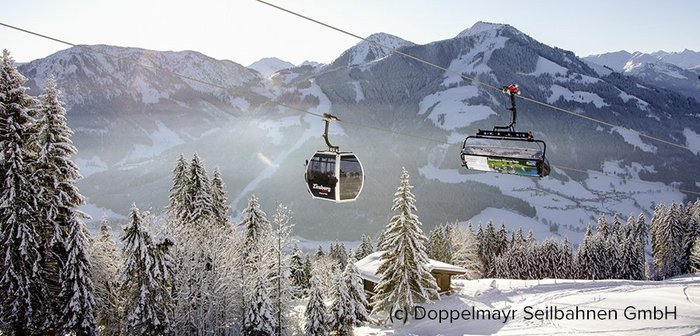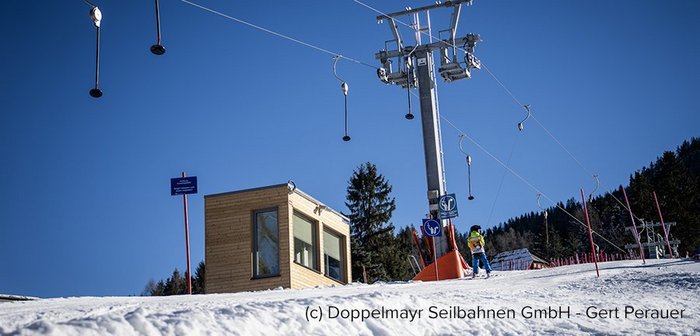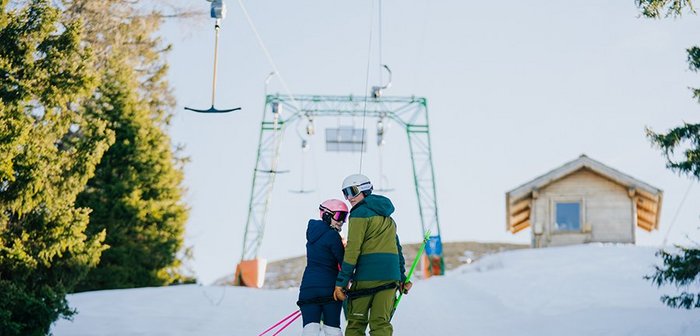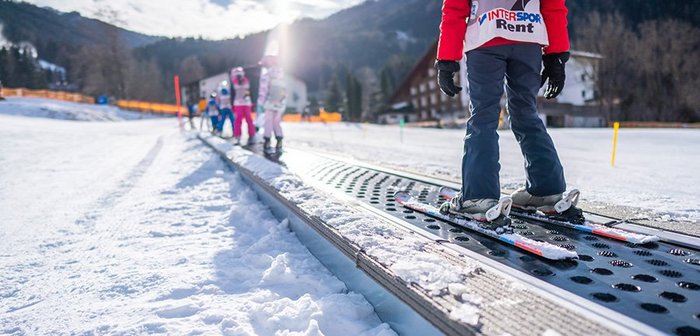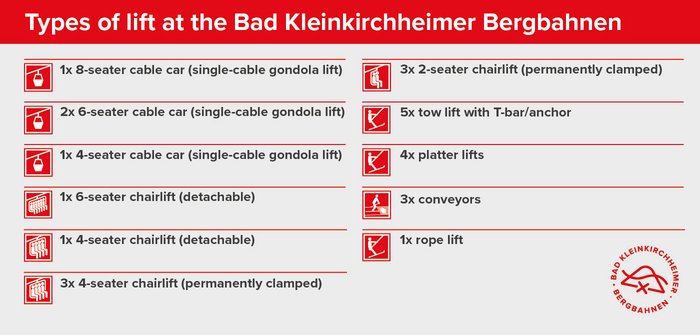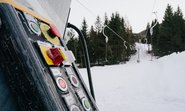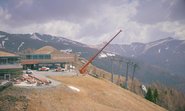From the valley to the mountain in just a few minutes – today's modern lifts and cable cars take us up to the most beautiful peaks on earth and a little closer to heaven. Riding a cable car is a luxury we’ve grown accustomed to – we can hardly remember the arduous climb that was once required to reach the peaks by many generations before us.
A lot has changed in terms of technology since the invention of the first modern cable cars for transporting passengers in the middle of the 19th century. Simple transportation aids have developed into an efficient and highly modern cable car system that is subject to strict safety standards and is considered one of the safest ways of getting from A to B.
But have you ever wondered how many different types of lift there actually are? You’ve probably been on most of them already. In this quick lesson on cable cars, we’d like to give you an insight into the complex jungle of cable cars and broaden your technical horizons a little bit. Come with us as we take you into a whole new world of cable car technology.
An invention on the up.
Long before they carried people, cable cars and ropeways were already being used to transport goods. The first time modern cable cars transported passengers was in urban transport systems and nowadays people are turning to this mode of transport again, realising they are the more sustainable and flexible option. But cable cars have never fallen out of favour for tourism and the economic development of the Alpine regions – and that includes the area around the Bad Kleinkirchheimer Bergbahnen.
Types of cable car system.
We already know about the difference between passenger cable cars and cargo cable cars, but the Austrian Cableway Act also divides them into the following 3 cable car systems:
- funicular railways
- aerial or suspension lifts and
- tow lifts
But what are the differences between the various systems? And where are they used?
1. Corners like it’s on rails: The funicular railway.
As the name suggests, funicular railways are located on solid ground, usually on rails, and are moved by one or more cables. This is what sets them apart from suspended aerial lifts and rack railways.
2. Floating through the air: The aerial and suspension lift.
You’d almost think they were floating through the air, if it wasn’t for the fact you can see the supporting pillars and suspension cables – it’s the aerial lifts. They transport passengers in a carriage on suspension cables and are pulled by one or more cables. All the lifts mentioned below fall into this category and you’re probably already familiar with some of them. But what is a funitel exactly?
> CHAIRLIFTS:
A classic among aerial lifts and the most common representative of this category found in ski resorts – it’s the chairlift. It’s relatively cheap to install and now boasts even more comfort with heated seats, covers and electronically operated bars with child safety locks. Modern ropeways can transport up to 10 people in one chairlift and carry fairly heavy loads.
> AERIAL TRAMWAYS:
They overcome every obstacle and are ideal for extreme terrain, high accessibility and wind stability. The Austrians refer to them as “pendulum cableways”, referring to the way in which they move: one or two cabins literally swing back and forth between two stations on a suspension cable. They are moved by the towing cable, which rotates around the guide wheels and the tensioning weight located in the summit station. Aerial tramways usually run on a fixed timetable and so are also increasingly being used in urban areas.
The world’s largest aerial tramway from Doppelmayr/Garaventa has a two-storey cabin and can carry up to 230 people at once. At a speed of 10 m/s, it transports around 2,000 passengers an hour. And it breaks two world records at once: it’s also supported by the world’s highest cable car pillar, which has a proud height of 188.88 metres.
> GONDOLA LIFTS:
Used to ferry passengers to new heights (they’ve borrowed the name from Venetian gondola boats), these lifts have several cabins moved by a cable that runs continuously in the same direction. The cars can be permanently connected to the conveyor or towing cable or automatically released at the stations.
8-seater cable car Biosphärenparkbahn Brunnach (Garaventa), Bad Kleinkirchheimer Bergbahnen, Austria.
> BICABLE AND TRICABLE GONDOLA LIFTS:
With this system, the number of cables determines which category they fall into. A bicable gondola lift has one support cable and one hauling cable, a tricable gondola lift (also known as a 3S gondola lift) has two support cables and one hauling cable, giving them even more stability and smooth traction – especially important during strong winds.
The tricable version is regarded as a particularly innovative and comfortable way of transporting passengers as it combines the advantages of the gondola lift with the benefits of an aerial tramway. Another appeal is that it’s capable of covering larger spans and can even manage curves. It scores highly in terms of sustainability thanks to the possibility of generating energy via the roller generator.
> FUNITEL:
Fun… what? You haven’t heard of it yet? Yes, it has a ‘fun’ name, but is it really something to get excited about? Well, this unique form of bicable gondola lift has the special features of parallel conveyor cables and very short suspension of the gondola. It promises to give passengers extra luxury over longer distances, so you can think of it more as a ski area shuttle. Even strong winds (up to over 100 km/h) hardly shake it.
> COMBINATION LIFTS:
The combination lift combines the advantages of a gondola lift and a chairlift by using both gondolas and chairs at the same time. The boarding and alighting areas are separated and tailored to the needs of the respective passengers
Combination lift Zinsbergbahn with 8-seater chair & 10-seater cable car (Doppelmayr), SkiWelt Wilder Kaiser-Brixental, Austria.
3. Uphill with traction: The tow lift
Widespread and probably familiar to everyone: tow lifts have been with us for as long as we can remember. A towing device, which is connected to a towing cable, transports both old and young passengers alike upwards – hence the name. Tow lifts are separated into two types, depending on the type of towing device:
> PLATTER LIFT:
Sounds like a cooking utensil, but you won’t find this type of ski lift in any kitchen. Our very own Bachlift belongs to this type. The name comes from the plate-shaped towing devices, which are attached to a conveyor cable running at a height of around six metres, powered by a retractor mechanism.
> T-BAR LIFT:
The T-bar lift also takes its name from the distinctive shape of the towing device. Passengers place the hangers attached to the towing cable under their bottoms and these are rolled up again by a retraction device when not in use. Modern hydraulic systems connected to the retraction equipment cushion the jolt when it starts up. Properly shifting your centre of gravity also makes it a more comfortable ascent option than the tow lift with low cable guide.
> ROPE LIFT OR TOW LIFT WITH LOW CABLE GUIDE:
Quite a rare sighting, but still the simplest way to reach the top of the mountain. Deflection pulleys at the bottom and top stations are the only guide points for the circulating towing cable and there are usually no supports. Instead, the passenger holds on to the towing cable directly. Small aids are attached to the cable at regular intervals to help them with this. These kinds of tow lift are usually only found on short practice slopes with a consistent, flat gradient. We have one of these here at St. Oswald; the baby ski lift.
> MAGIC CARPET:
As if by magic, our younger skiers are transported upwards via a rubberised conveyor belt – we call it the magic carpet. This is a special form of ground-level lift system and is mainly used on flat terrain. Hardly any children’s area can do without this type of kids lift these days, and our Bachlift is no exception.
“Permanently clamped” or “detachable”??
If you can explain these terms then it’s clear you already have a sound knowledge of cableway technology. They refer to the suspension on the cable, which can vary depending on the type of lift. “Permanently clamped” lifts are firmly connected to the cable with a clamp, just like T-bar lifts and some types of chairlift. Detachable chairlifts and gondola lifts are also attached to the cable, but can be detached from the cable at the station. The advantages are impressive:
- lower speed, making it easier for passengers to get on and off
- higher travel speed
- can carry more weight and provides more comfort for passengers
These are the reasons why detachable systems have been regarded as the “state of the art technology” of modern cableway systems since they were first launched onto the market in the 1980s.
And finally, a few figures.
As of 2024, Austria has a total of 2,648 lifts (Source: WKO). Which do you think is the most common type of cableway? The tow lift is the winner with 1,530 lifts, followed by detachable chairlifts and circulating lifts with closed cars as well as permanently clamped chairlifts. The gondola and funicular lifts are less common (1,118 lifts).
And which types of cable car will you find in our skiing area?
Are you already looking forward to your next ride on the tow lift, chairlift or funicular? You’ll definitely look at them with fresh eyes and maybe even impress your fellow passengers with your expertise. In any case, we’re already looking forward to taking you up to new heights again very soon

